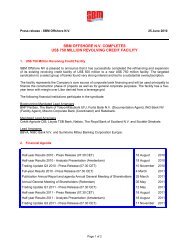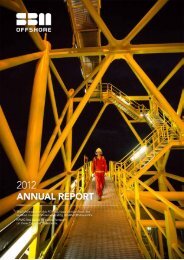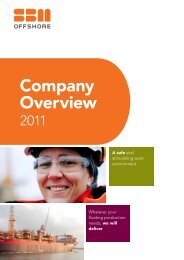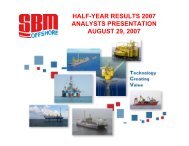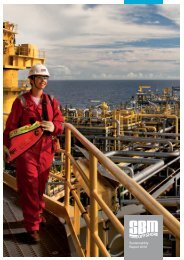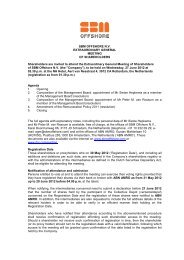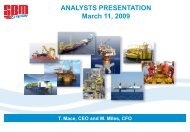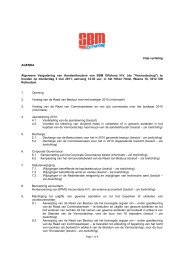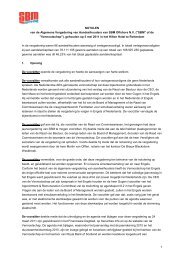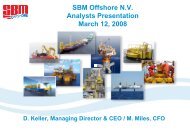Annual Report 2010 - SBM Offshore
Annual Report 2010 - SBM Offshore
Annual Report 2010 - SBM Offshore
You also want an ePaper? Increase the reach of your titles
YUMPU automatically turns print PDFs into web optimized ePapers that Google loves.
Funding risk<br />
Success in obtaining new lease and operate contracts<br />
requires significant amounts of debt to be arranged.<br />
This places pressure on the balance sheet but also<br />
provides an excellent opportunity to leverage higher<br />
returns on equity. The Company continues to be well<br />
supported by its banks due to a good performance<br />
record and high quality contracts. The funding risks on<br />
projects are monitored from project inception and no<br />
new lease project requiring finance is bid or accepted<br />
without first having received positive indications of<br />
financial support. A five-year financial model is maintained<br />
to anticipate longer term financing requirements,<br />
thus driving decisions on corporate and project finance.<br />
The project finance market continued to recover<br />
throughout <strong>2010</strong> and the refinancing and expansion of<br />
the revolving credit facility in June <strong>2010</strong> and the project<br />
debt financing for the Aseng project showed increased<br />
liquidity at attractive terms.<br />
The issue of credit availability is also being addressed<br />
by studying alternative sources of finance, including<br />
export credit agencies, capital markets and partners.<br />
Litigation<br />
From time to time, the Company has disputes with<br />
counterparties concerning contractual requirements<br />
and product performance. These are generally resolved<br />
amicably but litigation and arbitration may arise causing<br />
additional costs. Financial provisions are taken for<br />
any expected negative outcome, and recoveries are<br />
accrued when a positive result can be reliably projected<br />
and estimated.<br />
Treasury and liquidity risk<br />
The Company is exposed to financial market risks;<br />
mainly relating to currency and interest rates. The<br />
functional and reporting currency is US Dollars and<br />
almost all offshore revenues are effectively earned in<br />
US Dollars. There are however significant costs and<br />
some investments denominated in Euros and other<br />
non-Dollar currencies leading to potential exposures<br />
on profit and equity. The lease business is particularly<br />
capital intensive and substantially financed with floating<br />
rate debt giving rise to interest rate exposures.<br />
<strong>Report</strong> of the Board of Management<br />
The policy is to minimise profit volatility and hedge<br />
all significant currency and interest rate exposures<br />
as soon as they arise, using mainly fixed-rate instruments.<br />
No speculative activities are engaged in using<br />
financial instruments. The market value risk on financial<br />
instruments (in particular interest rate swaps) can be<br />
significant and, under International Financial <strong>Report</strong>ing<br />
Standards (IFRS) rules, market value variations impact<br />
reported equity values or in some cases profitability<br />
where the hedge does not accurately match the underlying<br />
exposure. This was the case in <strong>2010</strong> when interest<br />
rate swaps for the Deep Panuke platform were confirmed<br />
to exceed the actual interest rate exposure for<br />
that project. The notes to the Financial Statements provide<br />
details of financial instrument policies, sensitivities<br />
to exchange rate or interest rate movements, accounting<br />
treatments and market values.<br />
As a departure from the policy of full hedging, the<br />
equity and profit from activities of non-US Dollar<br />
denominated subsidiaries are not fully hedged. The<br />
resultant volatility is not considered material in the overall<br />
financial context.<br />
The Company does not use financial instruments to<br />
hedge during the bid phase for prospective projects but<br />
instead seeks to mitigate significant foreign exchange<br />
exposures through currency adjustment mechanisms<br />
in its tender prices. Where this is not possible, the<br />
Company is exposed to the currency and always to<br />
interest rate risk.<br />
Treasury prepares a twelve-month detailed cash plan<br />
on a quarterly basis to monitor liquidity and borrowing<br />
requirements with a high level two-year cash plan for a<br />
longer term view. The business unit cash plans are built<br />
up from the detail of each project to accurately forecast<br />
liquidity. Treasury reports cash and debt balances on<br />
a weekly basis, identifies and explains material divergences<br />
from the plan and takes corrective actions.<br />
Treasury reports every month to the Board of<br />
Management and quarterly to the Audit Committee of<br />
the Supervisory Board.<br />
<strong>SBM</strong> <strong>Offshore</strong> – <strong>Annual</strong> <strong>Report</strong> <strong>2010</strong> 93



